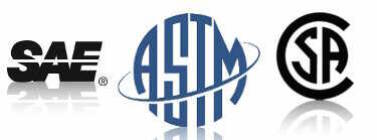What is the difference between SS316/SS304 and SS316L/SS304L?
Stainless steel type 316 and type 304 are raw material grades for stainless steel. Stainless steel fasteners are sometimes referred to and ordered as their raw material grades (such as SS 316 and SS304) and sometimes referred to and ordered as their ASTM specification. The common ASTM specifications that cover stainless steel bolts are A193, A320 and F593. Type 316 stainless has a unique chemical composition which includes 16% chromium, 10% nickel and 2% molybdenum. Type 304 stainless has 18% chromium, 8% nickel and no molybdenum (this is where the “18-8” designation comes from). Stainless steel 316 is more resistant to chlorides than stainless steel 304, making it the preferred material for marine construction.
Sometimes, a type “SS316L” or type “SS304L” bolt will be specified in a particular application. The “L” at the end of these designations refers to the low carbon content of the steel. Stainless steel certified to 316L or 304L will have a maximum of 0.03% carbon, versus the 0.08% maximum that regular 316 and 304 can have. Low-carbon stainless steel bolts are used to avoid corrosion problems that are caused by welding, as the lower carbon content reduces the “sensitization effect” (the precipitation of chromium carbides at grain boundaries) caused by the high temperatures involved in welding. Since carbon is the principal hardening element in steel, low-carbon bolts have reduced hardness but are easier to weld.
The difference in carbon content does not affect the overall corrosion resistance of the steel, and low-carbon stainless steel bolts can be ordered to each of the A193, A320 and F593 specifications. When you order a low-carbon stainless steel bolt, just let us know about this requirement and our expert estimators will be sure to provide you with the correct material.




@Ghulam- Apologies, but we do not do a lot of work in the fertilizer industry and do not know what is common or why.
We manufacture level gauges. When ss304/ss316 bolts are used for gauges having pressure more than 150 kg/cm2, these bolts need to tight before every hydro test. Otherwise gasket get burst at such high pressure. What is the cause of this ?
What properties of SS affect it ?
@Rakesh- Apologies, but we do not have the expertise to answer your question. You’d need to contact an engineer familiar with your project.
Hi
Can you give me an idea about the corresponding heat number for :
1- 3/4” 10 unc x 53/4” 316 bolt and nut
2- 1” 8 un x 53/4” 316 bolt and nut
Seriously needed for analysis on fasteners to order for our gas project. Your reply will be appreciated.
Thanks
@Amavi- We would be happy to help, but we are not sure exactly what you are asking. We have summaries of the chemical and mechanical requirements for these grades on our website if that might help.
What are the marking mentioned on SS304, SS316 & alloy steel bolts ??
@Srikanth- Bolts made to 304 or 316 do not have any marking requirements. Individual manufacturers may choose to mark their bolts, but it is not required. Bolts made to the ASTM bolting standards, ASTM F593 or A193 have specific requirements, and those can be found on our website.
which stainless steel will give better life with h2 so4 concentration 6-10 %
304 L OR 316 L
ALSO COST EFFECT
@Bhagwan- typically 316 stainless is more corrosion resistant, however for specific applications like this, a metallurgist should be consulted.
can we use SS 304 seam plate for packing in SS 304L piping line.
Please reply asap.
@Abhishek- We can’t make specific material recommendation. You should consult the project engineer.
What are the magnetic properties of SS316L?
@Wojciech- Magnetic properties can vary a bit depending on what manufacturing processes have been performed on the steel. Some processes can increase or decrease magnetism as the grain structure gets altered. A metallurgist may be able to more clearly explain the specifics.
Can we use 304 bolts, nuts & Washers, near to sea area ? Also How long 304 bolts can withstand against Corrosion ?
@Antony- SS304 is commonly used in many close-to-sea applications, but you’d need to consult with an engineer to see if that is the best material for your specific application and to determine what the expected service life would be.
Hi,
Can you provide the comparison for SS410 & SS316 in terms of strength and corrosion resistance?
I am looking for material which is high strength and good corrosion resistance. Thanks.
@Young- Typically speaking, ss410 is stronger than ss316, and ss316 is more corrosion resistant than ss410. However, there are manufacturing processes and heat treatment options that can drastically increase or decrease both strength and corrosion resistance. We would need to know many more specifics in order to answer your question.
Hi,
Could you please let me know what is hardness of SS316 and SS304 which i need to know for selecting the material for our application in paper factory.
Thanks,
Manu
@Manu- The only hardness required by A193 is a maximum of 223 HBN, there is no mimimum. Otherwise both 304 and 316 have identical tensile and yield values, 75ksi minimum tensile, 30ksi minimum yield.
thanks for this information Kailey
Hi,
Can you give me the similar comparison or differences between SS 321 and SS 304 also SS 321 and SS 316.
Thanks in advance for your reply.
Regards,
Virupaksh
@Virupaksh- Mechanically, 321/304/316 are identical, unless subsequent processing has been done. Chemically, 321 has titanium added to it, and has similar other elements to 316. 304 has slightly less Nickel than both 316 and 321. A complete comparison can be done by looking at the ASTM A276 standard.
Hi,
Could you direct me to the appropriate ASTM specification for a 3/4 inch countersunk stainless steel bolt?
Regards,
Jyotirmoy
@Jyortirmoy – Most of the off the shelf countersunk stainless bolts will not be manufactured to an ASTM standard, simply to 304/316 chemistry. If you require an ASTM standard, F593 is the general purpose ASTM standard, but they would need to made special in order to be certified to F593, as the industry has been slow to adopt the F593 standard.
Pressure Handling Capacity of SS 304 , SS316 & SS316L in bar or psi ?
@Abhishek – I am sorry, but we do not have that information. Apologies.
What is the maximum carbon in ss316
@George – For SS316 the max carbon is 0.08%. For SS316L it is 0.03%.
Generally bolts are not welded, if so why is 316L Bolts manufactured. is there any advantage over using SS 316L Bolts.
@Shyju – We don’t have any engineers on staff, so I cannot speak to all the possible advantages or disadvantages of SS316L vs SS316 material in various applications.
Hi everyone,
I am looking for a stainless steel that is easily turned, optically “looks” the same as SS316L, but more reasonably priced than SS316L. Any suggestions?
For the lower price I am willing to trade off some Corrosion resistance properties. Price and corrosion resistance of SS304 is well suited for my purpose, however SS304 has a yellowish color which does not suit the application.
Thanks in advannce for your inputs!!
@Deepak – Thank you for your inquiry, but we do not have any suggestions. Apologies.
dear sir
in orifice meters .which material is recommended to manufacture the orifice plate ss304 or ss316.
the product is dry gas.
operating pressure:21-70 bar.
flow rate:15mmscfd
I have a large boat kept in salt water. Which SS do you recomend?
Also, I have airplanes onw hich I plan on changing all screws to SS. Which SS do you suggest. They mainly ar on inspection plates and are not structrial.
The boat needs are not structrial as well.
Do you sell small quaities?
Thank you very much for your assistance.
John Thill, President
Garrett Development
@John Thill – we cannot make any recommendations, but of the two most common stainlesses (304 and 316), 316 is the more corrosion resistant. We can sell small quantities, however small screws are not really something we get into. Please feel free to contact us with your specific needs and if we can help, we will.
How would u Identify the materials ss316 and b8m??
@Sharbin – B8M (ASTM A193) bolts should be marked per the specification (mark is “B8M”) on the head of the bolt or at one end of the stud. SS316 is sometimes marked “316”, but not always, it will depend of the manufacturer. If the bolt is not marked, you would need to consult a test lab and they could perform some testing to determine the grade of fastener.
Hello,
What is require percentage of molybdenum in SS304 Material????? as per standard
@Dhananjay – There is no requirement for Molybdenum in 304 stainless. There are typically trace amounts, but it is not required. By contrast, stainless 316 requires 2.00-3.00% Molybdenum.
I need SS BOLT SS316 grade torque valu chart
@Harun – I am sorry, but we do not have any values for stainless steel fasteners. As with most torque values, they will be application specific and we are not able to make any recommendations.
Could you please tell me the differences in HEAT and STRENGTH TOLERANCES between Grade 8, 304SS, and 316L Bolts and NUTS?
Thank you
@Jim – The minimum strength requirements for bolts made to the above grades are identical, 30ksi minimum yield, 75ksi minimum tensile. For nuts, it will depend on the manufacturer. Nuts made per 304/304L or 316/316L may or may not be proofloaded since 304/316 is a material call out, not a nut specific one. For nuts made to A194 gr.8 or gr.8M, they should both be proofloaded to 80ksi for heavy hex, and 75ksi for finished hex.